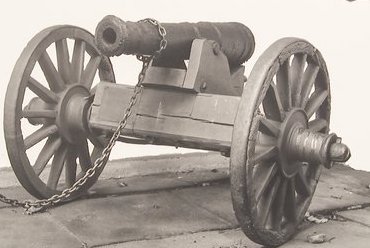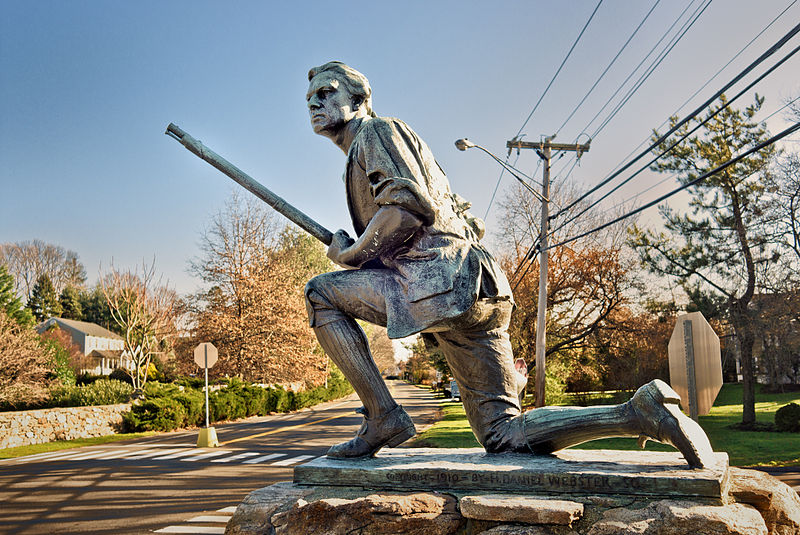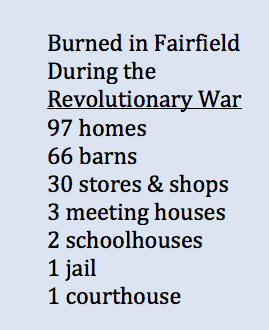Revolutionary War: The Burning of Fairfield

Revolutionary War cannon. Connecticut State Library
On July 7, 1779 residents of Fairfield awoke to the boom of a cannon. Isaac Jarvis, commander of the patriot’s fort at Black Rock, was sounding the alarm. A fleet of British warships had been spotted anchored off the coast.
Residents prepared for an attack. Some got ready to defend the town. Others quickly packed their belongings. They piled them in wagons and moved inland. They hoped to find safety with family or friends.
Everyone wondered, “Why were the British attacking Fairfield?”

Minuteman statue by Compo Beach in Westport which was part of Fairfield during the Revolutionary War. Much of Fairfield was burned by the British in July 1779.
Two years earlier, in April 1777, the British had also landed in Fairfield. But they hadn’t attacked the town. They had marched 24 miles inland to Danbury. Their mission was to destroy supplies that the Patriots had stored there. They left Danbury in flames and then marched back to their ships. Rebels had tried to stop them every step of the way. (Read about Benedict Arnold and the Battle of Ridgefield HERE.)
But this day would be different. The British were tired of the Patriot’s resistance. They had decided to attack towns close to the coast. They could attack and then get troops back quickly to the safety of their ships. New Haven, Fairfield, Norwalk, and, later, New London were targets.
The British came ashore in the afternoon. General William Tryon had about 800 soldiers with him. They landed at McKenzie’s Point—just two miles from the town center. They marched up the beach and then turned towards town. When they got near the fort, Fairfield’s militia fired its cannons. Militiamen fired their muskets.
British General George Garth and about 1,700 soldiers arrived a few hours later. They met up with Tryon’s troops to try to take the fort. They tried crossing Ash Creek, but found the planks of the bridge were gone. In frustration the British soldiers began burning homes. They kept burning buildings the next day as they returned to their ships.

Fairfield’s courthouse, meetinghouse, and jail were burned by the British in 1779. This is what they looked like in 1836, many years after the town was rebuilt. Drawing by John Warner Barber
William Wheeler lived in Black Rock. He was 15 years old. He later recalled:
The town burnt all night. … The poor inhabitants [were left] with no shelter, with no clothing but what they had on . . . . A Mr. Tucker fired from his shop … at the whole army only a few yards distant, & was wounded in the shoulder by them & taken prisoner. Mr. Parsons fired from a chamber into the road & killed a British officer; then running out the back door made his escape. The enemy . . . found an old [servant] bed-ridden; they said it was him [who killed the officer and] . . . put the bayonet into him & burnt the house . . . .
 When the British had left, four Americans had lost their lives. The town had lost nearly half its houses and most of its shops and businesses.
When the British had left, four Americans had lost their lives. The town had lost nearly half its houses and most of its shops and businesses.
It was many years before Fairfield recovered. Ten years later President George Washington visit Fairfield. He said, “The destructive evidences of British cruelty are yet visible both in Norwalk and Fairfield; as there are the chimneys of many burnt houses standing in them yet.”
This story is based on “Fairfield Set Ablaze,” Connecticut Explored, Spring 2009
“The Burning of Fairfield During the American Revolution,” fairfielct.org
Explore!
Fairfield Museum and History Center
370 Beach Road, Fairfield
(203) 259-1598
Fairfieldhistory.org





 When the British had left, four Americans had lost their lives. The town had lost nearly half its houses and most of its shops and businesses.
When the British had left, four Americans had lost their lives. The town had lost nearly half its houses and most of its shops and businesses.